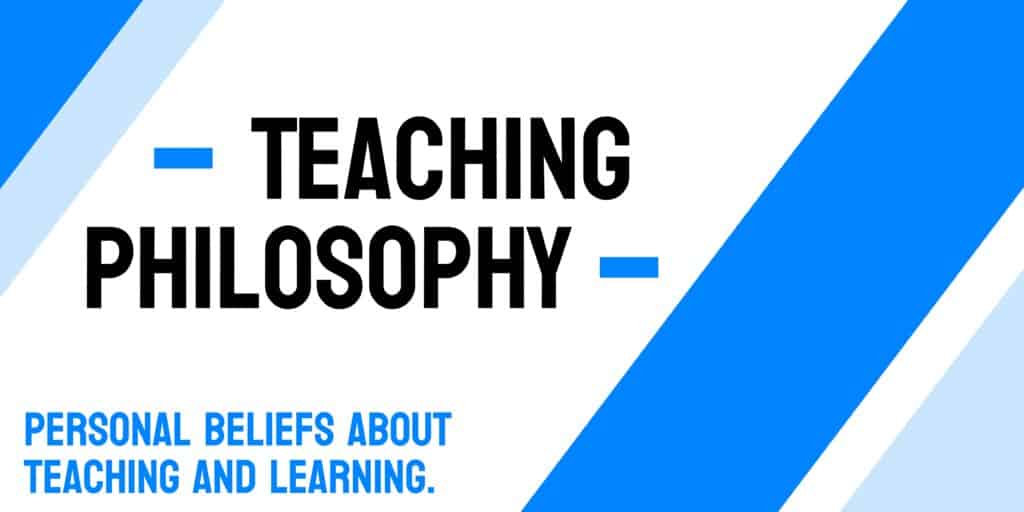What is a Teaching Statement?
A teaching statement (also referred to as a teaching philosophy) is a personal narrative reflecting one’s thoughts, beliefs, and experiences as an educator. It entails various components that outline teaching methods, best practices, and techniques in which to engage in continuous growth and learning. Any educator (regardless of their amount of time in the field) can create a teaching statement.
Why are Teaching Statements Important?
Teaching statements can be vital to the overall success of an educator. To produce a teaching statement, teachers must be extremely self-aware and mindful of their performance in the classroom. By doing this, they can properly self-reflect and implement necessary changes that ultimately influence student achievement. The creation of a teaching philosophy can also assist teachers in planning and directing future instruction and initiate the pursuit of additional resources.
It also allows teachers to evaluate themselves and their practices to determine their overall effectiveness and attitudes concerning the classroom. Additionally, teaching statements are beneficial when attempting to acquire a teaching position or a different role in the educational system as they inform others about your personal viewpoints on teaching before ever witnessing your performance in the classroom.
What are the Elements of a Teaching Statement?
Once the determination has been made that the creation of a teaching statement is necessary, the process of developing and organizing must begin. As mentioned before, several items can be included, and it is up to the individual teacher to decide which items are most suitable and useful for their philosophy. Below are some ideas to assist in the planning and creation of a personal teaching statement.
Introduction
To begin the teaching statement, start by introducing your personal teaching beliefs. Discuss why you selected teaching as your profession and why it is important to you. You may also include information about your specific teaching style and how it benefits your students in the classroom.
Body
For the body of the teaching statement, a plethora of items may be included; however, it is important to select items that are the most meaningful to you personally as an educator.
Outline Effective Instructional Practices
How do you approach instruction? Do you implement more teacher-centered instruction or student-centered instruction? Inform the reader how you operate when introducing content. Be sure to describe the structure of an average lesson in your classroom. In addition, it would be helpful to include information about what the students are doing throughout the day (i.e. hands-on activities, real-world applications, and so on).
Describe Your Classroom Environment
To fully grasp your teaching style and beliefs, those reading your teaching philosophy need to feel completely submerged in your classroom climate. Describe daily routines and other unique elements. How do you motivate students? Are students generally on task and engaged? What overall feeling do students and visitors feel upon entering the classroom? Use these questions as a starting point for informing readers (and yourself) about the health and environment that students work in on a daily basis.
Acknowledge Your Strengths
Self-reflection is such a huge component of developing a teaching statement. To reinforce positive classroom actions, you should identify the areas in which you perform well. You can do this by thinking about lessons that were received well by students, revisiting feedback from evaluations completed by administrators, etc. This is your chance to “shine” and describe what works well for you and your students!
Pinpoint Your Weaknesses
On the flip side, to improve teaching abilities, we have to be willing to openly and honestly identify areas in which we struggle. When referencing failed lessons, try to discover what went wrong. Look back at evaluation feedback and locate what area(s) they suggested to improve. Do not be afraid to share your weaknesses and include them in the teaching philosophy as this type of disclosure makes you appear more relatable and willing to seek change.
Understand Student Achievement
How do you assess student learning? What do you do with this information? Does it direct future instruction, and do you tailor teaching to meet the needs of students based on the data? Those reading your teaching statement will more than likely want to know if you are proactive in your role in the classroom. If students are struggling, do you reteach content and change your approach to best meet student needs? Describe how the assessment process looks for your students and how you utilize that information to direct instruction.
For all of these elements, including personal examples you have experienced is extremely important. Whether you are seeking improvement as an educator, applying for a different position, or pursuing a graduate degree, those reading the teaching statement will want to understand and believe in the information you are transferring to them. Including real examples makes your thoughts and teaching beliefs more relevant and gives them an idea of how you conduct yourself in the classroom. It is also wise to conduct the text from a first-person perspective as it reflects one’s personal experiences.
Conclusion
First, one of the best ways to conclude a teaching statement is to determine how your teaching philosophy enhances student learning. Next, you may decide to close your thoughts by developing professional goals that you would like to achieve. It is important that the teaching statement becomes a working document that redirects your focus as an educator to achieving student success and achieving personal goals. When this occurs, readers understand that you are flexible and intent on the idea of improving your teaching methods for years to come.
Additional Tips
To make the teaching statement more relatable and effective, it is important to reflect and report upon areas in which you excel. For instance, if you implemented an amazing unit in math where students used unique and exciting materials, describe it in full detail.
Another item that should be considered in detailing how your idea of teaching has changed or evolved with more time and experience. Are you open to new teaching and learning methods via technology and other resources? If so, explain steps you have taken or are willing to take to initiate such additions.
When formulating your personal teaching statement, it may be beneficial to survey fellow educators, administrators, or your students to understand your performance in the classroom better.
Educators never stop learning; check out our available graduate degree programs to hone your skills and promote lifelong learning and academic excellence.




